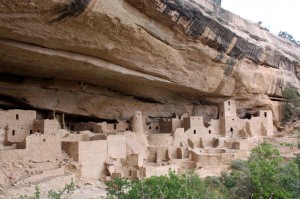When I first saw the headline I was hoping I’d find an article describing the first fruits of the turkey genome project (which I talked about back in november.) Instead, and still interestingly, what was just published in the Proceedings of the National Academy of Sciences was a study showing that wild turkeys have been domesticated twice by different cultures in the Americas.
The turkeys we eat today come from a breed domesticated by the Aztecs, living in present day Mexico (or proceeding cultures occupying that region). However this study, looking purely at mitochondrial DNA sequences was able to use DNA isolated from bones and turkey droppings to determine that turkeys kept by indigenous farmers in what is now the American southwest represented an independent domestication of wild turkeys from one of a couple of wild turkey subspecies found in North America. Given the uncertainties of archeological dating, the most recent evidence for the existence of this second form of domesticated turkey could be as early as 1400 AD or as late as 1840 AD.

The Cliff Palace, the largest of the ancient villages in Mesa Verde Park. Photo: j-fi, flickr (click to see photo in original context)
What’s fascinating to me is that, assuming the easier date is more accurate, that would mean these lost domesticated turkeys met their end a little while after villages across the same region begin to be abandoned.* The PNAS article itself mentions that this may be responsible for the discovery of mitochondrial DNA from these lost domestic turkeys in local wild populations:
… conditions in the late 1200s would have favored this process as Ancestral Puebloan groups migrated out of the Colorado Plateau, perhaps abandoning some of their flocks to fend for themselves.
Trying to herd a flock of turkeys while journeying to some unseen place that I’d likely never seen before is one of those life experiences I’m glad I’ll likely never have to experience.
On the other hand if the more recent extreme of dating in correct (1840), it’s not beyond the realm of possibility (although probably unlikely) that the lost domestic turkeys may someday be found on someone’s grandparents farm as can happen for lost breeds of roses and apple trees.
All in all, another interesting story that we’d likely never have known about without the awesome tools of modern molecular biology.
*If you ever get the chance to visit Mesa Verde Park in Colorado, I’d definitely recommend doing it. (The park preserves the stone buildings of the Anasazi/Ancient Pueblo people, who lived, farmed, and built stone villages in the region until they either left or died in the 13th century.) Many of the theories for the abandonment of their villages involve failures of agriculture (whether from extreme droughts or exhausting the local soil), so seeing the ruins was, for me, a stark reminder of how vulnerable any society, including our own, is to decreases in food production.

[…] domesticated twice, neither time in Turkey. Gobble, […]
Pingback by Science Report » Blog Archive » Nibbles: Kew web, Turkeys, Sugar — February 4, 2010 @ 1:58 am